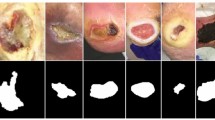Zusammenfassung
Chronic wounds including diabetic and arterial/venous insufficiency injuries have become a major burden for healthcare systems worldwide. Demographic changes suggest that wound care will play an even bigger role in the coming decades. Predicting and monitoring response to therapy in wound care is currently largely based on visual inspection with little information on the underlying tissue. Thus, there is an urgent unmet need for innovative approaches that facilitate personalized diagnostics and treatments at the point-of-care. It has been recently shown that ultrasound imaging can monitor response to therapy in wound care, but this work required onerous manual image annotations. In this study we present initial results of a deep learning-based automatic segmentation of cross-sectional wound size in ultrasound images and identify requirements and challenges for future research on this application. Evaluation of the segmentation results underscores the potential of the proposed deep learning approach to complement non-invasive imaging with Dice scores of 0.34 (U-Net, FCN) and 0.27 (ResNet-U-Net) but also highlights the need for improving robustness further.We conclude that deep learning-supported analysis of non-invasive ultrasound images is a promising area of research to automatically extract cross-sectional wound size and depth information with potential value in monitoring response to therapy.
Access this chapter
Tax calculation will be finalised at checkout
Purchases are for personal use only
Preview
Unable to display preview. Download preview PDF.
Similar content being viewed by others
Literatur
Järbrink K, Ni G, Sönnergren H, Schmidtchen A, Pang C, Bajpai R et al. The humanistic and economic burden of chronic wounds: a protocol for a systematic review. Syst Rev. 2017;6(1):1–7.
Nelzén O, Bergqvist D, Lindhagen A. Long-term prognosis for patients with chronic leg ulcers: a prospective cohort study. Eur J Vasc Endovasc Surg. 1997;13(5):500–8.
Frykberg RG, Banks J. Challenges in the treatment of chronic wounds. Adv Wound Care (New Rochelle). 2015;4(9):560–82.
Medina A, Scott PG, Ghahary A, Tredget EE. Pathophysiology of chronic nonhealingwounds. J Burn Care Rehabil. 2005;26(4):306–19.
Mantri Y, Tsujimoto J, Penny WF, Garimella PS, Anderson CA, Jokerst JV. Point-of-care ultrasound as a tool to assesswound size and tissue regeneration after skin grafting. Ultrasound Med Biol. 2021;47(9):2550–9.
Wang C, Anisuzzaman DM,Williamson V, Dhar MK,Rostami B, Niezgoda J et al. Fully automatic wound segmentation with deep convolutional neural networks. Sci Rep. 2020;10(1):1– 9.
Huang S, Dang J, Sheckter CC, Yenikomshian HA, Gillenwater J. A systematic review of machine learning and automation in burn wound evaluation: a promising but develo** frontier. Burns. 2021.
Ronneberger O, Fischer P, Brox T. U-Net: Convolutional networks for biomedical image segmentation. Medical Image Computing and Computer-Assisted Intervention. Ed. by Navab N, Hornegger J, Wells WM, Frangi AF. 2015:234–41.
Shelhamer E, Long J, Darrell T. Fully convolutional networks for semantic segmentation. IEEE Trans Pattern Anal Mach Intell. 2017;39(4):640–51.
Chen S, Dorn S, Lell M, Kachelrieß M, Maier A. Manifold learning-based data sampling for model training. Proc BVM. 2018:269–74.
Perez L, Wang J. The effectiveness of data augmentation in image classification using deep learning. 2017.
Moghimi S, Miran Baygi MH, Torkaman G, Mahloojifar A. Quantitative assessment of pressure sore generation and healing through numerical analysis of high-frequency ultrasound images. J Rehabil Res Dev. 2010;47(2):99–108.
Author information
Authors and Affiliations
Corresponding author
Editor information
Editors and Affiliations
Rights and permissions
Copyright information
© 2022 Der/die Autor(en), exklusiv lizenziert an Springer Fachmedien Wiesbaden GmbH, ein Teil von Springer Nature
About this paper
Cite this paper
Schlereth, M. et al. (2022). Initial Investigations Towards Non-invasive Monitoring of Chronic Wound Healing Using Deep Learning and Ultrasound Imaging. In: Maier-Hein, K., Deserno, T.M., Handels, H., Maier, A., Palm, C., Tolxdorff, T. (eds) Bildverarbeitung für die Medizin 2022. Informatik aktuell. Springer Vieweg, Wiesbaden. https://doi.org/10.1007/978-3-658-36932-3_56
Download citation
DOI: https://doi.org/10.1007/978-3-658-36932-3_56
Published:
Publisher Name: Springer Vieweg, Wiesbaden
Print ISBN: 978-3-658-36931-6
Online ISBN: 978-3-658-36932-3
eBook Packages: Computer Science and Engineering (German Language)




